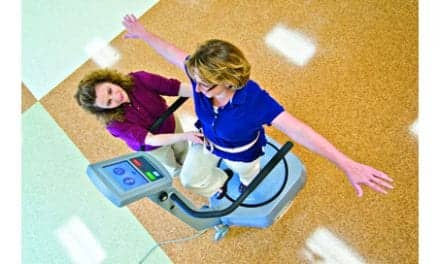 |
Musculoskeletal conditions have been found to affect nearly one in every seven Americans, and include chronic back pain, arthritis, osteoporosis, as well as knee and hip conditions (including joint replacements). As Baby Boomers grow older and remain active in the workplace, as well as athletic activities, increasing numbers will need electrical stimulation therapies for their ailments.
For example, among the most common conditions for which electrical stimulation is used are carpal tunnel syndrome (CTS) and fracture management. CTS affects the wrist and hand in all ages, but primarily in individuals over the age of 50. Long hours on the computer and other types of repetitive hand stress cause the painful numbness. Although severe cases are treated with surgery and steroids, studies have shown that ultrasound can speed healing along with reducing wrist swelling in more moderate cases. Interferential current therapy (IFC) is helpful for wrist swelling, and some therapists recommend transcutaneous electric nerve stimulation (TENS) for self-treatment of pain.
The most widely used electrical stimulation therapies are ultrasound, e-stim, and TENS/IFC. Ultrasound works by delivering acoustic vibrations via a transducer that uses a quartz crystal to convert electrical energy to ultrasonic waves, which are applied to tissues for therapeutic purposes.
The heat from ultrasound therapy goes deeper into the tissues than any other modality, 4 to 6 cm. The benefits include pain reduction; muscle relaxation; increased local metabolism; and increased flexibility of connective tissue. The continuous and pulsed modes of ultrasound are an effective tool for treating many conditions, such as sports injuries, sprained ankles, carpal tunnel, lower back problems, tendons, joints, scar tissue, edema, muscle spasm, and female urinary problems. The conditions that rule out ultrasound are: pregnancy, cancer, recent scarring in the affected area, a pacemaker, circulatory problems, and severe infection.
Ultrasound can be used in tandem with other modalities such as ice and therapeutic massage. Anti-inflammatory drugs can be “pushed” deep into the affected site via pulsed ultrasound. Physical therapists like to use ultrasound for patients with severe pain. According to physical therapist Jonathan “Joey” Jove, who works with James Donaldson Fitness Centers in Tacoma, Wash, he has logged significant success in treating elderly patients using ultrasound. He says that the heat it produces loosens muscles so they can start a program of gentle soft tissue work.
“My patients with acute pain are sometimes afraid of physical therapy until they experience the heat and relief that ultrasound provides,” says Jove.
As innovations continue to develop for ultrasound, the depth of penetration is more easily calculated on newer models. Standard overall treatment plans have been developed including mobilization, stretching, and therapeutic exercise to maximize the full potential of the ultrasound modality.
Currently, most reimbursement plans cover a limited number of ultrasound treatments.
THE BENEFITS OF E-STIM
E-stim, or electrical stimulation therapy, involves placing electrodes on various affected body points to recruit muscle fibers and contract them via electricity. The process tells the muscles to expand and contract when the patient is unable to move voluntarily. The current setting can be adjusted to promote a gentle or forceful muscle contraction. E-stim also promotes blood supply to the contracting muscle, which assists healing.
If the muscle being treated is denervated (lost physical connection with its nerve supply), the electrical stimulation can maintain nutrition through promoting blood flow, decrease fibrotic changes, and retard denervation atrophy. If the e-stim is being used on muscles that do have a nerve supply, atrophy can be prevented or reversed.
E-stim can help to relax spasmodic muscles. It also can increase the motion and range of muscles that have been restricted from disuse or atrophy. E-stim helps stimulate tissues after surgery or being in a cast. After a stroke, e-stim is helpful in rehabilitating muscles, and can aid in stimulating calf muscles to prevent venous thrombosis.
Used in cases of muscle strain and tear, swelling after injury, edema, postsurgical tendon and cartilage repair, and post-orthopedic surgery, e-stim can be provided by a professional or used for self-treatment with a portable unit. Insurance covers both in most cases. Patients with pacemakers or who are pregnant should not use e-stim. Other health conditions, such as circulation problems and cancer, should be carefully monitored by health professionals before the modality is recommended.
The latest consumer models of e-stim continue to get smaller and lighter, with simpler controls.
CONTROLLING PAIN
TENS is a method of nerve stimulation designed to control pain. The TENS unit is made up of one or more signal generators, a set of electrodes, and a battery. They can be set to variable strengths, pulse rates, and widths. The preferred waveform is biphasic, to avoid the electrolytic and iontophoretic effects of a unidirectional current. TENS has been used in conjunction with painkillers after surgery, and can often replace dependence on narcotics for chronic pain.
 |
| Jonathan “Joey” Jove, PT, oversees his patient’s use of an electromyographic device to determine contraction of her quadriceps muscle. |
TENS is used for several conditions, such as arthritis, osteoarthritis, low back pain, acute sprains, sports injuries, tendonitis, bursitis, carpal tunnel, phantom limb pain, postoperative pain, and peripheral nerve injury. TENS should be avoided by pregnant patients, or those with pacemakers.
TENS is usually applied in one of the following methods—Conventional short-pulse duration: The patient applies the electrodes and wears them all day, turning the stimulus on for 30-minute intervals. Acupuncture: TENS provides low-frequency stimulus trains of 1 to 10 Hz, close to the pain tolerance of the patient. This method is recommended for patients who do not respond well to conventional TENS, but is very uncomfortable and not easily tolerated. Pulsed (burst): Low-intensity stimuli in high-frequency bursts.
Insurance pays for clinic and home units on a regular basis. Studies show an initial 70% to 80% pain relief success rate for TENS, which drops to 20% to 30% after a few months.
Many therapists recommend self-treatment in pain management cases, the theory being that by taking control of their own therapy, a patient’s outlook might be improved. Physical therapist Katherine Verling, who works out of Cedars-Sinai Orthopedic Center, Los Angeles, likes patients to self-treat except in cases where they may not be able to place the electrodes correctly.
“I’ve had success using TENS in a clinical assisted situation,” says Verling, “[but patients cannot] reach the most effective spot for electrode placement without help. Just a few visits helped to relieve their pain.”
Recent innovations are smaller units with automatic turnoff when electrode wires become loose, and easier to read controls.
A LOW-FREQUENCY ENERGY SOURCE
IFC is similar to TENS but uses two medium-frequency currents that “interfere” with each other and produce a frequency that the body recognizes as a low-frequency energy source. IFC can be used in almost any situation where inflammation is present. Interferential currents penetrate the skin easily and may have more direct cellular effect below the skin. They also may be less disturbing to the patient since little energy is accumulated in the skin.
|
For more information on electrical stimulation, read “Functional Stimulation” for an account of using functional electrical stimulation for spinal cord injuries. |
IFC can deliver higher currents than TENS and uses several applicators on regions like the back, or in different planes in complex regions like the shoulder. IFC should be restricted to the same contraindications as TENS. It is covered by insurance for most usage. The units are getting smaller, lighter, and simpler to use for self-treatment.
Electrical stimulation therapies are critical to rehabilitation. “If you don’t address pain, you can’t move the affected areas, and if you can’t move them, you can’t strengthen them,” says Jove. Overall, they have become an important part of many rehabilitation or pain relief programs.
Cathy Logan is a contributing writer for Rehab Management. For more information, contact
BIBLIOGRAPHY
- Christensen KD. Adjunctive therapies to the adjustment: successful ankle sprain management. Health-Nexus Net; 2005.
- Kaye V, Brandstater ME. Transcutaneous electrical nerve stimulation. eMedicine J. 2002;3(1).
- Musculoskeletal conditions in the United States. Available at: http://medicalreporter. health.org/tmr1099/orthopaedics.html.. Accessed October 2, 2006.
- Naser MA, Hahn KA, Liberman BE, Branco KR. Carpal tunnel pain treated with low-level laser and TENS: a controlled study. Arch Phys Med Rehabil. 2002;83:978-88.
- Watson T. Interferential therapy. Electrotherapy Newsletter. 2006; Electro-News.





